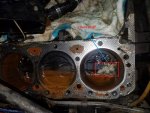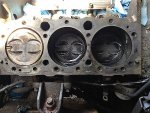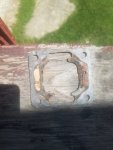I have a 1990 4.3. I drained the block last fall and parked it with no further winterizing (I'm a bad person, I know).
Fast forward 8 months to this weekend. I was tearing down the engine to do a vortec cylinder head swap. I removed the old heads to find standing water (and rust) in 5 of the cylinders. I pulled the oil dipstick and found the level was about 2 quarts too high and very milky. There was a white substance on top of two pistons that looked and felt like Crisco. The head gaskets *looked* fine, but I've never seen a bad one so I'm not certain if they were OK.
There was rust on both banks of exhaust valves and on ports of both exhaust manifolds. The intake manifold and intake valves all looked just fine. No rust.
The boat did overheat once, about ~20 engine hours before being winterized. The overheat was noticed when smoke was coming from the engine compartment. It was shut off, cooled, and restarted without issue. Replaced the thermostat and ran the rest of summer without any noticeable performance issues.
My questions:
1: How can water get into BOTH banks of cylinders? Is it possible that water just came in through one spot, then after being still for 8 months of winter, managed to "evaporate" its way to the cylinders? Since the oil was milky and WAY too full, this appears to have happened during regular usage and isn't a result of bad winterizing.
2: How did the block manage not to hydro-lock if I found water inside the cylinders?
3: Could this water be related to the overheat? I've read in places that overheats can kill exhaust flappers and riser gaskets. Is it likely I toasted those on both sides?
4: What is the Crisco stuff on top of the pistons?
5: If I leak down check the block, will that verify if the rusted cylinder walls and oil/compression rings are OK?
At this point, it looks like the first step is to pressure check the exhaust manifolds since they are removed. If those check fine, I would reassemble the heads and intake and pressure check the block. This would check for water leak sources and check if the rusted cylinders still hold compression.
I have had this boat for 6 years with no previous water ingestion issues.
Any thoughts and responses to the questions are greatly appreciated.
Further info for anyone who needs it:
1990 4.3 non balance shaft, alpha one gen one. Mariah 1850XL 18.5' open bow runabout.
Engine serial: 0C768924
Transom serial: 0688349
Drive serial: 0D301183
Fast forward 8 months to this weekend. I was tearing down the engine to do a vortec cylinder head swap. I removed the old heads to find standing water (and rust) in 5 of the cylinders. I pulled the oil dipstick and found the level was about 2 quarts too high and very milky. There was a white substance on top of two pistons that looked and felt like Crisco. The head gaskets *looked* fine, but I've never seen a bad one so I'm not certain if they were OK.
There was rust on both banks of exhaust valves and on ports of both exhaust manifolds. The intake manifold and intake valves all looked just fine. No rust.
The boat did overheat once, about ~20 engine hours before being winterized. The overheat was noticed when smoke was coming from the engine compartment. It was shut off, cooled, and restarted without issue. Replaced the thermostat and ran the rest of summer without any noticeable performance issues.
My questions:
1: How can water get into BOTH banks of cylinders? Is it possible that water just came in through one spot, then after being still for 8 months of winter, managed to "evaporate" its way to the cylinders? Since the oil was milky and WAY too full, this appears to have happened during regular usage and isn't a result of bad winterizing.
2: How did the block manage not to hydro-lock if I found water inside the cylinders?
3: Could this water be related to the overheat? I've read in places that overheats can kill exhaust flappers and riser gaskets. Is it likely I toasted those on both sides?
4: What is the Crisco stuff on top of the pistons?
5: If I leak down check the block, will that verify if the rusted cylinder walls and oil/compression rings are OK?
At this point, it looks like the first step is to pressure check the exhaust manifolds since they are removed. If those check fine, I would reassemble the heads and intake and pressure check the block. This would check for water leak sources and check if the rusted cylinders still hold compression.
I have had this boat for 6 years with no previous water ingestion issues.
Any thoughts and responses to the questions are greatly appreciated.
Further info for anyone who needs it:
1990 4.3 non balance shaft, alpha one gen one. Mariah 1850XL 18.5' open bow runabout.
Engine serial: 0C768924
Transom serial: 0688349
Drive serial: 0D301183

























